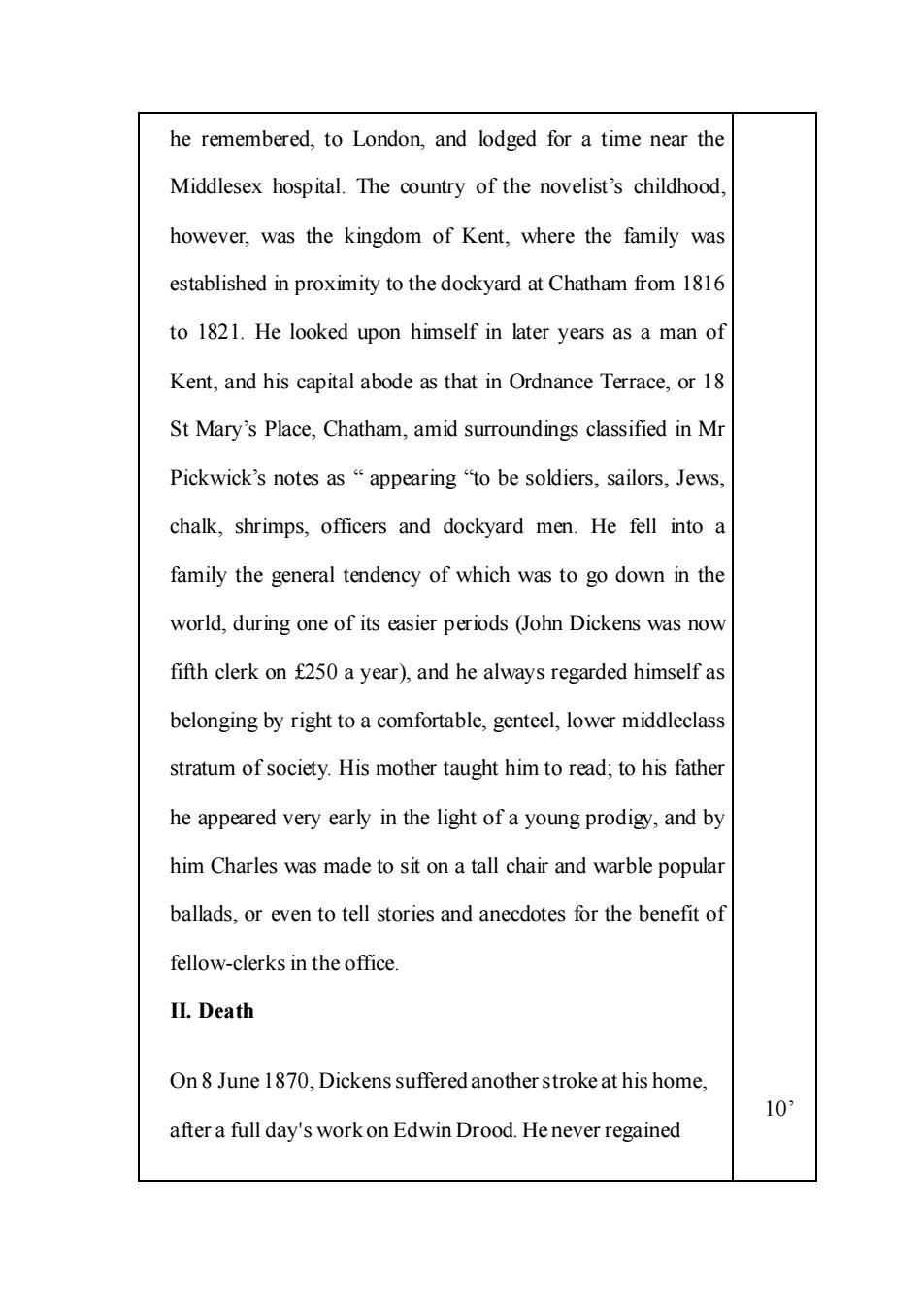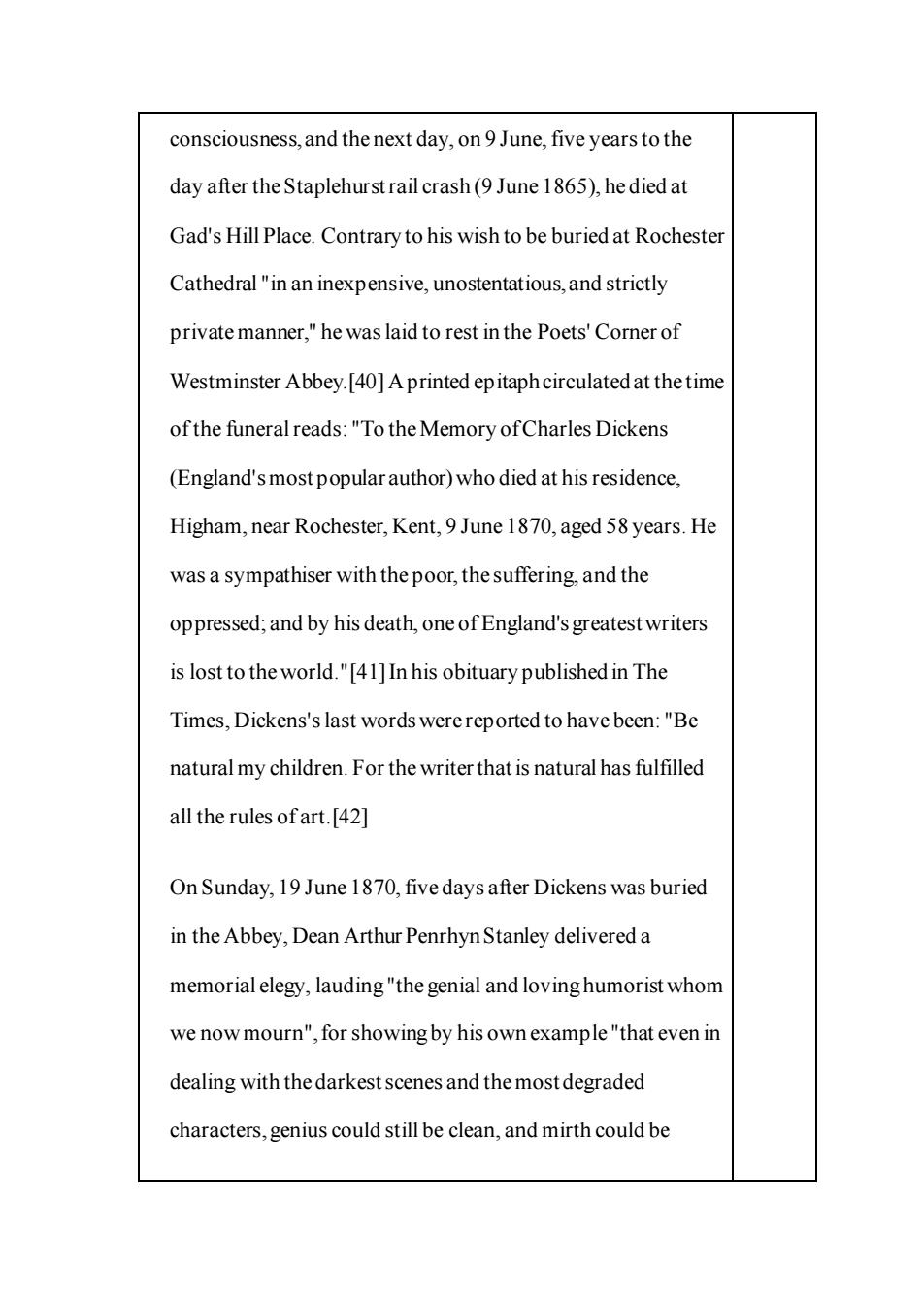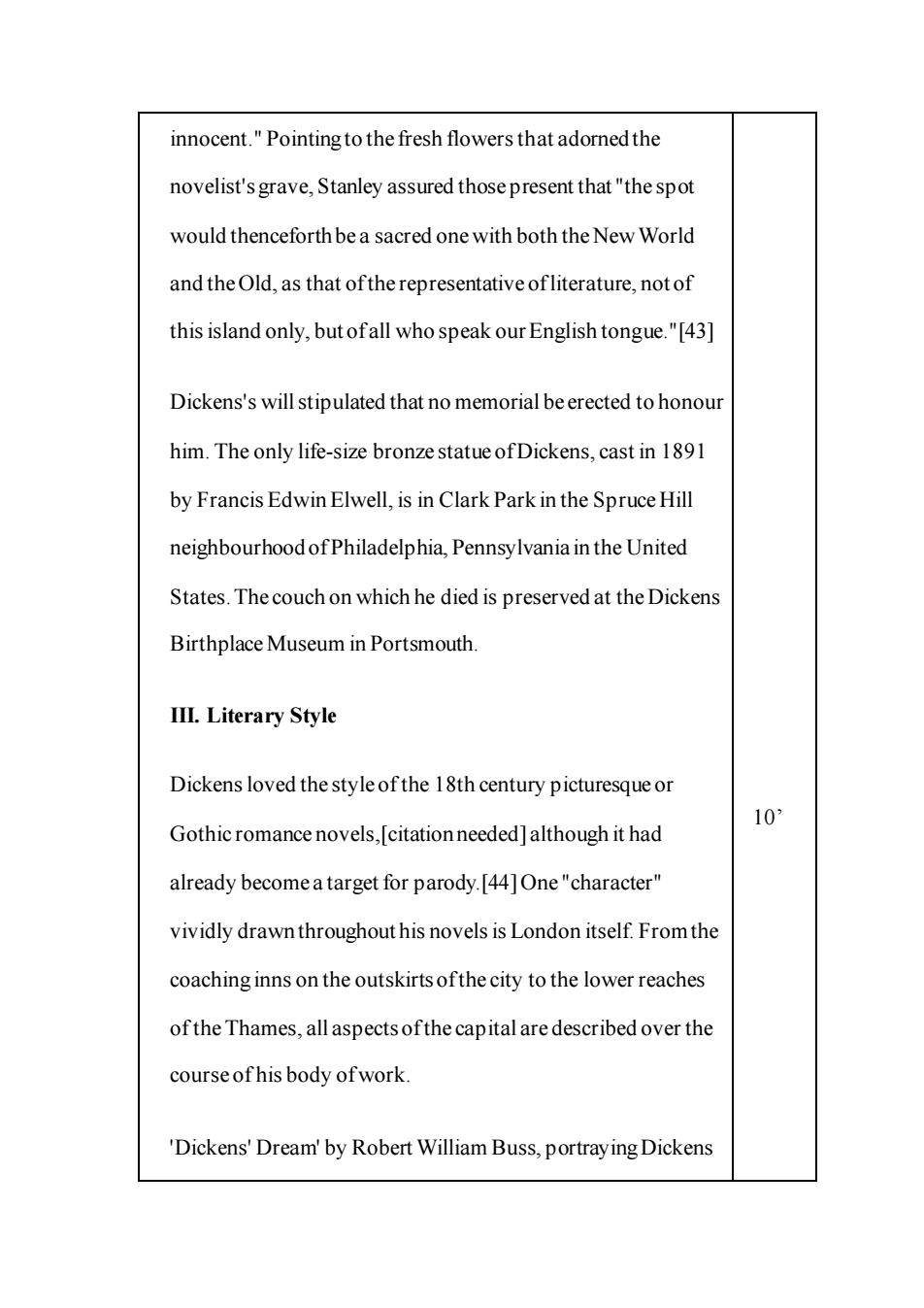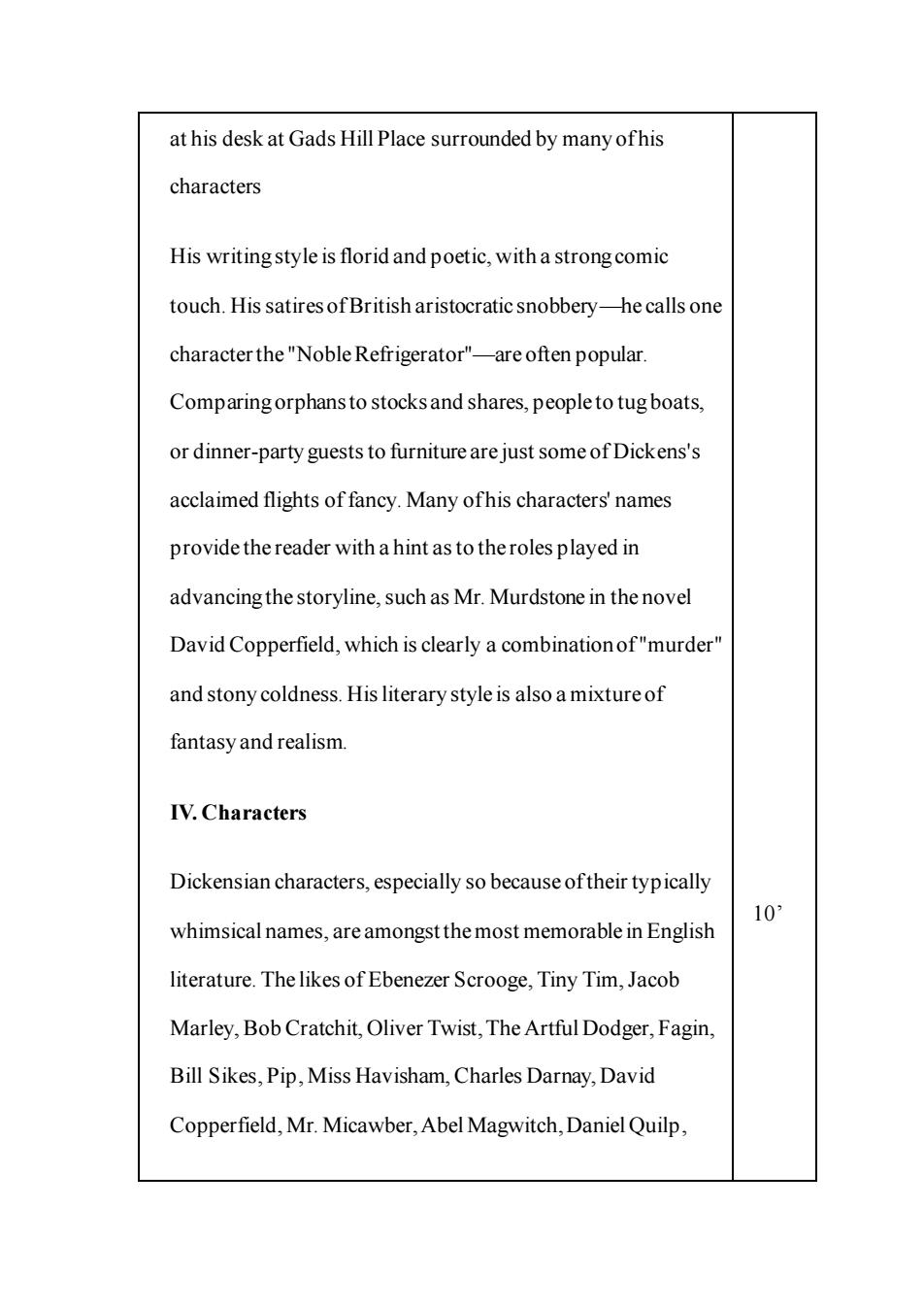
教案 课程名称 英国文学 授课专业和班级 英语本科 授课内容 Charles Dickens 授课学时 2 To let the students see the significance of literature; 教学目的 To let the students have the general impression of British literature. To let the students get basic knowledge of British literature To get to know the general clue of British literary history 教学重点与 To get to know the important British writers and literary works 难点 To get to know some key terms To know some methods for literary appreciation and criticism 教学方法 sin class 辅助手段 Projector,audio-video machine I.Life DICKENS,CHARLES JOHN HUFFAM (1812-1870), English novelist,was born on the 7th of February 1812 at a house in the Mile End Terrace,Commercial Road,Landport 10: (Portsea)a house which was opened as a Dickens Museum on 22nd July 2904.His father John Dickens(d.1851),a clerk in the navy-pay office on a salary of f80 a year,and stationed for the time being at Portsmouth,had married in 1809 Elizabeth,daughter of Thomas Barrow,and she bore him a family of eight children,Charles being the second.In the winter of 1814 the family moved from Portsea in the snow,as
教 案 课程名称 英国文学 授课专业和班级 英语本科 授课内容 Charles Dickens 授课学时 2 教学目的 To let the students see the significance of literature; To let the students have the general impression of British literature. To let the students get basic knowledge of British literature 教学重点与 难点 To get to know the general clue of British literary history To get to know the important British writers and literary works To get to know some key terms To know some methods for literary appreciation and criticism 教学方法 Open questions and answersin class Class discussion and analysis 辅助手段 Projector, audio-video machine I. Life DICKENS, CHARLES JOHN HUFFAM (1812—1870), English novelist, was born on the 7th of February 1812 at a house in the Mile End Terrace, Commercial Road, Landport (Portsea)—a house which was opened as a Dickens Museum on 22nd July 2904. His father John Dickens (d. 1851), a clerk in the navy-pay office on a salary of £80 a year, and stationed for the time being at Portsmouth, had married in 1809 Elizabeth, daughter of Thomas Barrow, and she bore him a family of eight children, Charles being the second. In the winter of 1814 the family moved from Portsea in the snow, as 10’

he remembered,to London,and lodged for a time near the Middlesex hospital.The country of the novelist's childhood, however,was the kingdom of Kent,where the family was established in proximity to the dockyard at Chatham from 1816 to 1821.He looked upon himself in later years as a man of Kent,and his capital abode as that in Ordnance Terrace,or 18 St Mary's Place,Chatham,amid surroundings classified in Mr Pickwick's notes as "appearing"to be soldiers,sailors,Jews. chalk,shrimps,officers and dockyard men.He fell into a family the general tendency of which was to go down in the world,during one of its easier periods (John Dickens was now fifth clerk on f250 a year),and he always regarded himself as belonging by right to a comfortable,genteel,lower middleclass stratum of society.His mother taught him to read;to his father he appeared very early in the light of a young prodigy,and by him Charles was made to sit on a tall chair and warble popular ballads,or even to tell stories and anecdotes for the benefit of fellow-clerks in the office. II.Death On8 June 1870,Dickens suffered another stroke at his home, 10 after a full day's work on Edwin Drood.He never regained
he remembered, to London, and lodged for a time near the Middlesex hospital. The country of the novelist’s childhood, however, was the kingdom of Kent, where the family was established in proximity to the dockyard at Chatham from 1816 to 1821. He looked upon himself in later years as a man of Kent, and his capital abode as that in Ordnance Terrace, or 18 St Mary’s Place, Chatham, amid surroundings classified in Mr Pickwick’s notes as “ appearing “to be soldiers, sailors, Jews, chalk, shrimps, officers and dockyard men. He fell into a family the general tendency of which was to go down in the world, during one of its easier periods (John Dickens was now fifth clerk on £250 a year), and he always regarded himself as belonging by right to a comfortable, genteel, lower middleclass stratum of society. His mother taught him to read; to his father he appeared very early in the light of a young prodigy, and by him Charles was made to sit on a tall chair and warble popular ballads, or even to tell stories and anecdotes for the benefit of fellow-clerks in the office. II. Death On 8 June 1870, Dickens suffered another stroke at his home, after a full day's work on Edwin Drood. He never regained 10’

consciousness,and the next day,on 9 June,five years to the day after the Staplehurstrail crash(9 June 1865),he died at Gad's Hill Place.Contrary to his wish to be buried at Rochester Cathedral"in an inexpensive,unostentatious,and strictly private manner,"he was laid to rest in the Poets'Corner of Westminster Abbey.[40]Aprinted epitaphcirculatedat thetime ofthe funeral reads:"To the Memory ofCharles Dickens (England's most popular author)who died at his residence, Higham,near Rochester,Kent,9 June 1870,aged 58years.He was a sympathiser with the poor,the suffering,and the oppressed;and by his death,one of England's greatest writers is lost to the world."[41]In his obituary published in The Times,Dickens's last words werereported to have been:"Be natural my children.For the writer that is natural has fulfilled all the rules ofart.[42] On Sunday,19 June 1870,five days after Dickens was buried in the Abbey,Dean Arthur Penrhyn Stanley delivered a memorial elegy,lauding "the genial and loving humorist whom we now mourn",for showing by his own example "that even in dealing with the darkest scenes and the most degraded characters,genius could still be clean,and mirth could be
consciousness, and the next day, on 9 June, five years to the day after the Staplehurst rail crash (9 June 1865), he died at Gad's Hill Place. Contrary to his wish to be buried at Rochester Cathedral "in an inexpensive, unostentatious, and strictly private manner," he was laid to rest in the Poets' Corner of Westminster Abbey.[40]A printed epitaph circulated at the time of the funeral reads: "To the Memory of Charles Dickens (England's most popular author) who died at his residence, Higham, near Rochester, Kent, 9 June 1870, aged 58 years. He was a sympathiser with the poor, the suffering, and the oppressed; and by his death, one of England's greatest writers is lost to the world."[41]In his obituary published in The Times, Dickens's last words were reported to have been: "Be natural my children. For the writer that is natural has fulfilled all the rules of art.[42] On Sunday, 19 June 1870, five days after Dickens was buried in the Abbey, Dean Arthur Penrhyn Stanley delivered a memorial elegy, lauding "the genial and loving humorist whom we now mourn", for showing by his own example "that even in dealing with the darkest scenes and the most degraded characters, genius could still be clean, and mirth could be

innocent."Pointing to the fresh flowers that adorned the novelist's grave,Stanley assured those present that"the spot would thenceforth be a sacred one with both the New World and theOld,as that ofthe representativeofliterature,notof this island only,but ofall who speak our English tongue."[43] Dickens's will stipulated that no memorial beerected to honour him.The only life-size bronze statue of Dickens,cast in 1891 by Francis Edwin Elwell,is in Clark Park in the Spruce Hill neighbourhood of Philadelphia,Pennsylvania in the United States.The couch on which he died is preserved at the Dickens Birthplace Museum in Portsmouth. III.Literary Style Dickens loved thestyleofthe 18th century picturesque or 10 Gothic romance novels,[citationneeded]although it had already becomea target for parody.[44]One"character" vividly drawn throughout his novels is London itself.From the coaching inns on the outskirts ofthe city to the lower reaches of the Thames,all aspects ofthe capital are described over the course ofhis body ofwork. 'Dickens'Dreamby Robert William Buss,portraying Dickens
innocent." Pointing to the fresh flowers that adorned the novelist's grave, Stanley assured those present that "the spot would thenceforth be a sacred one with both the New World and the Old, as that of the representative of literature, not of this island only, but of all who speak our English tongue."[43] Dickens's will stipulated that no memorial be erected to honour him. The only life-size bronze statue of Dickens, cast in 1891 by Francis Edwin Elwell, is in Clark Park in the Spruce Hill neighbourhood of Philadelphia, Pennsylvania in the United States. The couch on which he died is preserved at the Dickens Birthplace Museum in Portsmouth. III. Literary Style Dickens loved the style of the 18th century picturesque or Gothic romance novels,[citation needed] although it had already become a target for parody.[44]One "character" vividly drawn throughout his novels is London itself. From the coaching inns on the outskirts of the city to the lower reaches of the Thames, all aspects of the capital are described over the course of his body of work. 'Dickens' Dream' by Robert William Buss, portraying Dickens 10’

at his desk at Gads Hill Place surrounded by many ofhis characters His writing style is florid and poetic,with a strong comic touch.His satires of British aristocratic snobbery-he calls one character the"Noble Refrigerator"-are often popular Comparingorphans to stocks and shares.people to tug boats. or dinner-party guests to furniture arejust some of Dickens's acclaimed flights of fancy.Many ofhis characters'names provide the reader with a hint as to theroles played in advancingthe storyline,such as Mr.Murdstone in the novel David Copperfield,which is clearly a combinationof"murder and stony coldness.His literary style is also amixtureof fantasy and realism. IV.Characters Dickensian characters,especially so because oftheir typically whimsical names,are amongst the most memorable in English o. literature.The likes of Ebenezer Scrooge,Tiny Tim,Jacob Marley,Bob Cratchit,Oliver Twist,The Artful Dodger,Fagin, Bill Sikes,Pip,Miss Havisham,Charles Darnay,David Copperfield,Mr.Micawber,Abel Magwitch,Daniel Quilp
at his desk at Gads Hill Place surrounded by many of his characters His writing style is florid and poetic, with a strong comic touch. His satires of British aristocratic snobbery—he calls one character the "Noble Refrigerator"—are often popular. Comparing orphans to stocks and shares, people to tug boats, or dinner-party guests to furniture are just some of Dickens's acclaimed flights of fancy. Many of his characters' names provide the reader with a hint as to the roles played in advancing the storyline, such as Mr. Murdstone in the novel David Copperfield, which is clearly a combination of "murder" and stony coldness. His literary style is also a mixture of fantasy and realism. IV. Characters Dickensian characters, especially so because of their typically whimsical names, are amongst the most memorable in English literature. The likes of Ebenezer Scrooge, Tiny Tim, Jacob Marley, Bob Cratchit, Oliver Twist, The Artful Dodger, Fagin, Bill Sikes, Pip, Miss Havisham, Charles Darnay, David Copperfield, Mr. Micawber, Abel Magwitch, Daniel Quilp, 10’